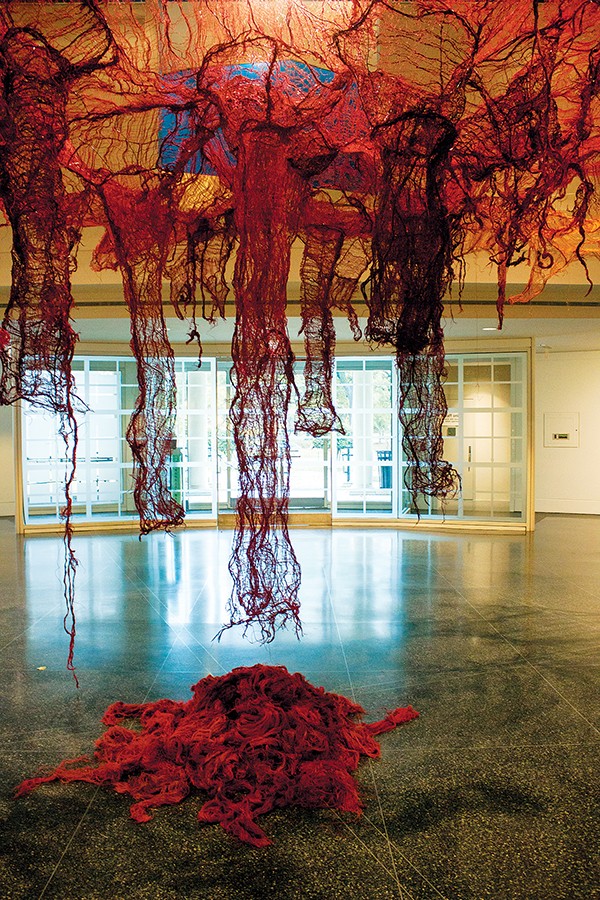Wheeler Williams’ 1961 female forms “Spring, Summer, Fall,” flanking the main entrance of the Brooks Museum, cycles from birth to death.
In a softer and much more abstract way, Nnenna Okore’s “Sheer Audacity” also offers commentary on aging, deterioration, and the temporary state of things.
“Sheer Audacity” is the second in the Brooks’ Rotunda Series, a part of the museum’s year-long centennial celebration. Assembled over two days and designed especially for the rotunda, Okore’s installation follows the looming “Rage of the Ballet Gods” by another artist of Nigerian descent, Yinka Shonibare.
Okore teaches sculpture at Chicago’s North Park University. The daughter of a professor and a librarian, she often examines her American identity versus her Nigerian identity and the contrasts between her homeland with that of the States. She says her works are inspired by the landscape and natural attributes. Her works also require tedious processes, time-consuming steps, and repetitions, something she says she enjoys greatly, a reflection of the non-microwave nature of completing simple tasks (specifically cooking) in Nigeria.

Nnenna Okore’s “Sheer Audacity” at the Brooks Museum of Art
Okore’s exhibition, like Shonibare’s, examines the relationship between humans and the environment. While Shonibare’s art explores climate change via Greek mythology, Okore’s burlap work draws inspiration from the environment and the decay and erosion of natural objects. The three themes that guided her throughout the creation of the piece were transience, transformation, and the breaking down of objects.
“Sheer Audacity” descends from the floor above. There’s webbing and multiple figurative limbs, so that visitors don’t just view the work, they inhabit it. They can press their faces right up to burlap, smell the slight mustiness the material emits.
The heavy use of red, a favorite color of Okore’s, makes the piece feel like a living organism, and it takes on a quality of an aquatic animal — a three-dimensional sketch of an octopus or an exploded jellyfish. The piece is punctuated with blobs of orange, blue, and burgundy, and a pile of fabric sits in a heap on the floor in the center of the piece as if said creature has shed its skin or rid itself of waste.
Okore’s pieces typically consist of organic materials, often burlap or reclaimed discarded materials such as old magazines, phone books, plastic grocery bags, or newspapers. The use of found objects is a way for her to showcase the abundant nature of such materials and to critique American wastefulness, consumerism, and excess. Her work allows her a chance to return those items back to a natural state and offer a brief stay in the cycle of depletion of those natural resources.
Each installation of Okore’s typically takes two to three months to create. Okore transported this work in smaller pieces to Memphis from Chicago not knowing what the final form would look like until she started putting it together.
The shrinking, shriveling, and shedding of the burlap used in “Sheer Audacity” reveals the beauty in aging and shows how fleeting everything is around us, how everything, all of us, last but a while.